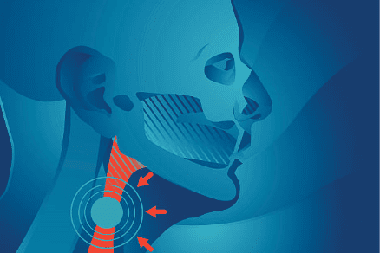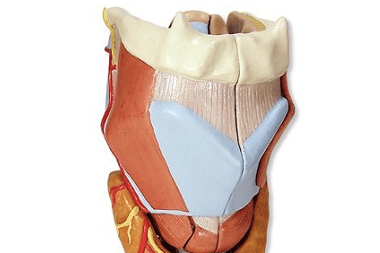Oncology >>>> Laryngeal cancer signs, treatment and prognosis
Laryngeal cancer signs, treatment and prognosis.

Laryngeal cancer is an oncological disease that develops mainly in males (80-90%) at the age of forty to sixty years.
The causes of laryngeal cancer and the factors that provoke it are:
- Long smoking period,
- Drinking alcoholic beverages,
- Working conditions associated with a high degree of dust and / or high temperatures,
- Chemical vapors (including paints and varnishes, gasoline, welding aerosols),
- Metal dust.

The larynx is clinically divided into three sections (supraglottic section, ligamentous section, subglottic section), and depending on which section the cancer is located in, the aggressiveness of the tumor and the rate of its metastasis can be characterized. The most aggressively spreading tumor is located in the supraglottic larynx. This is due to the well-developed lymph flow system in the supraglottic region, which allows the tumor to scatter metastases to the surrounding organs.

The location of the cancer in the ligamentous section is considered more favorable, since it is poor in lymphatic vessels, which prevents the tumor from actively metastasizing. In this case, the tumor rarely metastasizes. If the tumor is located in the subglottic region (which is extremely rare), then it metastasizes to the pre-laryngeal and / or pre-tracheal lymph nodes.
When making a prognosis for the course and treatment of laryngeal cancer, the form of tumor growth is of great importance: exophytic, endophytic, mixed.
The exophytic form of laryngeal cancer is distinguished by a tuberous and papillary surface, has clear boundaries and grows mainly in the lumen of the larynx.
The endophytic form of laryngeal cancer manifests itself as an infiltrate with ulceration, has no clear boundaries and grows mainly in the thickness of the tissues adjacent to it.
Laryngeal cancer may be preceded by precancerous conditions: leukoplakia, leukokeratosis, pachyderma, laryngeal papilloma. Most often, precancers and laryngeal cancer are located in the vestibular region of the larynx.
The signs of laryngeal cancer depend on which part of the larynx the tumor is located in:
- Discomfort during swallowing, stiffness of the epiglottis (loss of elasticity of the cartilage) and the sensation of the presence of a foreign body in the larynx are observed when the tumor is located in the subglottic region. As the tumor grows, pain occurs at the time of swallowing, and over time, its intensity increases. In advanced stages of laryngeal cancer, pain radiates to the ears. The sick person refuses to eat, loses weight from malnutrition. The rigidity of the epiglottis prevents the larynx from closing tightly at the time of swallowing and provokes choking, dysphagia and coughing.
- Hoarseness, shortness of breath during exertion, and after a while and difficulty breathing speak of a tumor located in the ligamentous part of the larynx.
- Such signs of cancer of the larynx as a hoarseness and shortness of breath during inhalation can talk about the location of the tumor in the subglottic larynx.
Laryngeal cancer is diagnosed based on laryngoscopy, histological examination, radiography and computed tomography. To diagnose metastases, the method of palpation of the nodes of the regional lymphatic system is used. The area of communication of the common facial vein with the internal jugular vein is examined most carefully in case of suspected laryngeal cancer. To exclude diseases similar in symptoms (lymphadenitis, lymph node hyperplasia), a cytological study is performed under ultrasound control for lymph node metastasis with laryngeal cancer.
Laryngeal cancer treatment aims not only to cure the patient from tumor progression, but also to restore the functions of the larynx (respiratory, vocal, protective).
Laryngeal cancer treatment consists of the stages of radiation therapy, surgery, chemotherapy and their combinations. Radiation therapy affects not only the tumor itself, but also the areas of its metastasis. Surgical intervention is performed with the aim of resecting the larynx in the area of the tumor. The extent of the resection depends on the degree of tumor damage to one or another part of the larynx. Resection is performed with subsequent endoprosthetics of the removed parts of the larynx (cartilage).
For the treatment of regional metastases in laryngeal cancer, in addition to radiation, lymph nodes are excised. When metastases capture the jugular vein and / or sternocleidomastoid muscle, the Craille operation (resection of these anatomical elements) is performed.
Chemotherapy is given in combination with radiation therapy and surgery. For chemotherapy, cisplatin, bleomycin, carboplatin, 5-fluorouracil, phosphamide, docetaxel, paclitaxel and methotrexate are usually used alone or in combination with each other.
The prognosis of laryngeal cancer is formed under the influence of the location of the tumor, the form of its growth, the radiosensitivity of the tumor, the stage of the process and the degree of metastasis. On average, after radical treatment, the survival rate is 5 years. Depending on the stage at which the treatment was started, the number of residents of this period decreases (at the second stage - 55-70%; at the third stage - from 35% and below).

Read

Read



























